Enchiladas in Mexico were a revelation. If you are an American, you probably know enchiladas as I do - tortillas stuffed with some usually meaty filling, rolled up or folded over, and baked in a dish, covered with a mildly spicy sauce. A topping of melting cheese completes the picture.
Growing up, Mom's enchiladas were flour tortillas filled with a mixture of ground beef browned with onion. The tortillas were dipped in Las Palmas mild enchilada sauce. They were topped with shredded American cheese. We loved them. A popular present to take when visiting sisters who had moved away from California was a case of Las Palmas, so they could make enchiladas just like mom's.
In Oaxaca, enchiladas were a different animal. Corn tortillas were dipped in a thick coating of enchilada sauce, folded in neat quarters like a hanky and served three to a plate. They were garnished with a tiny piece of fresh cheese and a few whispers of onion slices.
Similar dishes were enmoladas - tortillas dipped in one of the region's 7 famous mole sauces - or enfrijoladas, tortillas dipped in a thinned-down paste of refried beans. Are you starting to see a pattern? I guess you can pretty much en[dip]alada with anything.
At this time of year, I make an enchilada that bears no resemblance to anything traditional. They are delicious, vegetarian and easy to make. I have fed them to everyone from captains to kings (ok, maybe not kings, but my pre-teen nephews ate them happily) with compliments all around.
Butternut Enchiladas
1 medium butternut squash, halved , seeded, and baked until soft
Cream cheese - from half to a whole package, depending on how fat-friendly you are
1 bunch green onions, sliced in thin rings, including some of the green part
Some shredded monterey jack or queso quesadilla cheese, amount to your taste
12 flour tortillas
1 large can Las Palmas mild enchilada sauce
While the squash is still hot, combine it with the cream cheese and onions. Stir until cream cheese gets melty.
Oil a 13x9 baking dish or spray with cooking spray. Use a lot - this WILL stick to the pan. Pour enough sauce in the dish to coat the bottom with a thin layer.
Put rest of sauce on a flat plate or pan. Dip tortillas in sauce on one side. Place them, sauce side down, in the dish. Put a blob of squash mixture on them. Roll up. Do this until you run out of tortillas or squash, which will vary depending on how crazy you get with the squash mix.
Pour any remaining sauce over the assembled enchiladas. Top with shredded cheese - as much or as little as you like. I like a little. Cotija cheese crumbles would also work, come to think of it.
Bake for about 25 minutes in a 400 degree oven, covered if you like them soft or uncovered if you like crispy crunchy edges.
Serve with rice and a nice green salad.
Tuesday, October 18, 2005
Tuesday, October 11, 2005
Agua de Tuna
If you have some rudimentary Spanish skills, you are probably thinking "Tuna water? Yuk!"
Fooled you. "Tuna" is the Mexican name for the fruits of prickly-pear cactuses. The red fruits are sweet and filled with tiny black seeds.
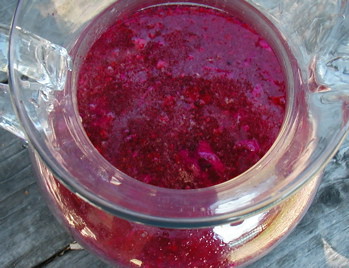
Tunas are good to peel and eat, or you can make a drink out of them.
I had my first Agua de Tuna outside a church in Zaachila, Oaxaca one hot Sunday afternoon last summer. A tiny woman was selling cups full of the magenta liquid out of a plastic bucket. The drink was sweet and refreshing, perfect.
When I saw tunas at Whole Foods the other day, I snapped some up and made this:
Agua de tuna y naranja (Cactus-orange drink)
3 red ripe tunas
3 cups of water
Juice of one orange
Sugar to taste - just a bit
Peel and chop the tunas fine. You can strain the seeds out if you want but they add texture and mostly sink to the bottom, anyway.
Juice the orange. Mix the tunas and orange juice with the water and sugar, stir and refrigerate. Simple.
When I heard that La Dolce Vita was sponsoring a food meme called "In the Pink" to raise breast cancer awareness, I was sad to miss the entry deadline. But in the spirit of Mexico, where time isn't so important, consider this lovely pink drink my entry.
Fooled you. "Tuna" is the Mexican name for the fruits of prickly-pear cactuses. The red fruits are sweet and filled with tiny black seeds.

Tunas are good to peel and eat, or you can make a drink out of them.
I had my first Agua de Tuna outside a church in Zaachila, Oaxaca one hot Sunday afternoon last summer. A tiny woman was selling cups full of the magenta liquid out of a plastic bucket. The drink was sweet and refreshing, perfect.
When I saw tunas at Whole Foods the other day, I snapped some up and made this:
Agua de tuna y naranja (Cactus-orange drink)
3 red ripe tunas
3 cups of water
Juice of one orange
Sugar to taste - just a bit
Peel and chop the tunas fine. You can strain the seeds out if you want but they add texture and mostly sink to the bottom, anyway.
Juice the orange. Mix the tunas and orange juice with the water and sugar, stir and refrigerate. Simple.
When I heard that La Dolce Vita was sponsoring a food meme called "In the Pink" to raise breast cancer awareness, I was sad to miss the entry deadline. But in the spirit of Mexico, where time isn't so important, consider this lovely pink drink my entry.
Sunday, October 09, 2005
Fairview Gardens "Fields of Plenty" Festival
Fairview Gardens in Goleta, California, just north of Santa Barbara is a tiny jewelbox of a farm wedged between subdivisions on all sides.
Michael Ableman and a crew of workers and volunteers have created a thriving organic farm in a most unlikely place and have turned it into a demonstration and teaching center as well as a source of impeccably fresh produce for people in the surrounding area.
My new pal Martha and I took in the "Fields of Plenty" festival there this afternoon. We ambled the fields, tasted about 10 different varieties of squash, and feasted on a meal of tamales, fresh tortillas, beans, rice and three tremendous salsas.
The squash tasting may not have been the best idea. They had roasted about 10 different kinds of squash plain and were serving them at room temperature on toothpicks for $5. Hm.
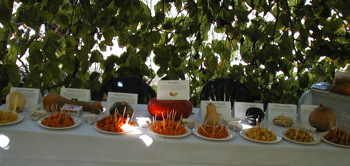
Most people are already not THAT crazy about squash, especially when it isn't hot, and the $5 price was assuring that there weren't many takers. We went for it. I am a big proponent of side-by-side tastings and I figured "When am I ever going to get a chance to taste squash side-by-side again?" It just doesn't come up every day, you know. My favorites were the dense sweet squashes like butternut and kabocha. Martha preferred the lighter, more subtle delicata.
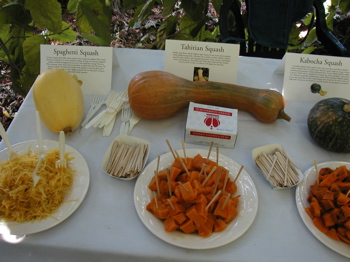


The cool part about the squash tasting is that it took place under a big old mulberry tree that had branches that reached all the way to the ground, making a green room to stand in.
Martha
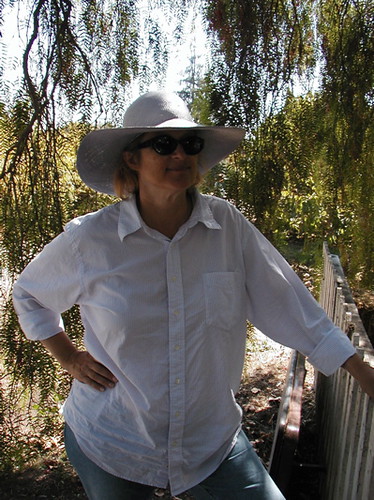
1890 Farmhouse built by the Hollister Family. This is the band doing a sound check.
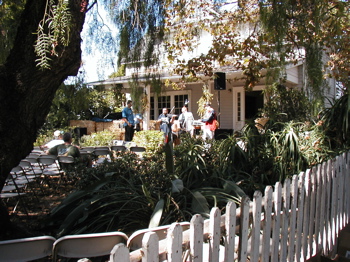
Me hanging out under the tree
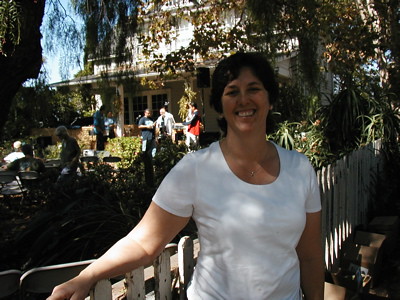
Walking the fields on a warm fall afternoon was idyllic. The farm have lovely big chickens in a pen out in an orchard, brown ones and my favorites, the black and white ones that look checkered. An organic farm is so interesting because they grow a mix of crops to confuse the bugs and to improve the soil. I don't know how many crops they had there, but we saw lettuces, broccoli, onions, garlic, flowers, guavas, cherimoyas, citrus, squash, pumpkins, avocados, stone fruits, passion fruits, beets, basil, carrots, fennel, oh gosh, what else? A lot.
At lunch we sat with the nicest family. Or group of friends. I was never sure of everyone's relationship, but they were a bunch of Latino musicians who had come from Fresno and San Francisco to play there under the big pepper tree. One young man, Javier, sat down at our table, then more and more people kept coming and greeting each other, talking, laughing, telling stories, kids crawling on people's laps, giving hugs, sharing food. It was just a happy scene full of love and caring and I know Martha and I both felt lucky and charmed to be included.
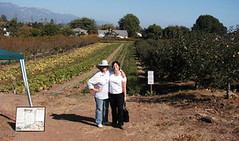
Michael Ableman and a crew of workers and volunteers have created a thriving organic farm in a most unlikely place and have turned it into a demonstration and teaching center as well as a source of impeccably fresh produce for people in the surrounding area.
My new pal Martha and I took in the "Fields of Plenty" festival there this afternoon. We ambled the fields, tasted about 10 different varieties of squash, and feasted on a meal of tamales, fresh tortillas, beans, rice and three tremendous salsas.
The squash tasting may not have been the best idea. They had roasted about 10 different kinds of squash plain and were serving them at room temperature on toothpicks for $5. Hm.

Most people are already not THAT crazy about squash, especially when it isn't hot, and the $5 price was assuring that there weren't many takers. We went for it. I am a big proponent of side-by-side tastings and I figured "When am I ever going to get a chance to taste squash side-by-side again?" It just doesn't come up every day, you know. My favorites were the dense sweet squashes like butternut and kabocha. Martha preferred the lighter, more subtle delicata.



The cool part about the squash tasting is that it took place under a big old mulberry tree that had branches that reached all the way to the ground, making a green room to stand in.
Martha

1890 Farmhouse built by the Hollister Family. This is the band doing a sound check.

Me hanging out under the tree

Walking the fields on a warm fall afternoon was idyllic. The farm have lovely big chickens in a pen out in an orchard, brown ones and my favorites, the black and white ones that look checkered. An organic farm is so interesting because they grow a mix of crops to confuse the bugs and to improve the soil. I don't know how many crops they had there, but we saw lettuces, broccoli, onions, garlic, flowers, guavas, cherimoyas, citrus, squash, pumpkins, avocados, stone fruits, passion fruits, beets, basil, carrots, fennel, oh gosh, what else? A lot.
At lunch we sat with the nicest family. Or group of friends. I was never sure of everyone's relationship, but they were a bunch of Latino musicians who had come from Fresno and San Francisco to play there under the big pepper tree. One young man, Javier, sat down at our table, then more and more people kept coming and greeting each other, talking, laughing, telling stories, kids crawling on people's laps, giving hugs, sharing food. It was just a happy scene full of love and caring and I know Martha and I both felt lucky and charmed to be included.

Saturday, October 01, 2005
Pakistani Cooking Class
The Ojai area about 70 miles north of Los Angeles is never more lovely than on a fall afternoon. It is always lovely, of course -- that's why was used to represent Shangri-La in the movies -- but something about the fall, when the withering summer heat has passed and a soft breeze kicks up, is just magical.
It was in this setting that we eight eager cooking enthusiasts came to learn a bit about Pakistani cooking from the talented Dodo Mufti.
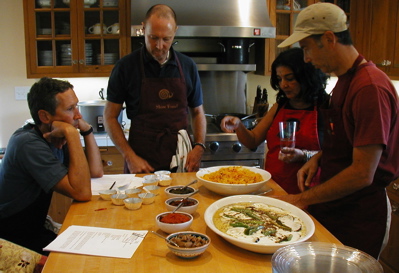
Two men well-known in the local food scene hosted the class in a sweet farmstyle hideaway on a hill outside of town. They have a fabulous kitchen that manages to be both professional and cozy at the same time - it features both an industrial-strength Viking range AND three Laborador Retrievers (one in each color).
Dodo is originally from Bombay (Mumbai) India and learned to cook at the side of her mother-in-law, a Pakistani.
Pakistani food has much in common with Northern Indian cuisine, explained Dodo and her husband Tariq. The garam masala spice mixes are ground exceedingly fine, dishes are served with a variety of chutneys, and usually, meals from the Muslim country are meat-based, unlike the more vegetarian Hindu south. But today's adventure was pure vegetarian, a perfect lunch meal for a warm day.
In fact, Dodo said, the eggplant dish would only be served as a lunch, never as a dinner. Like the musical ragas that are only played at certain times of the day, there are dishes that are inextricably tied to a certain meal. And they are eaten in a certain fashion: when rice is served, bread is not.
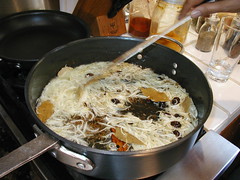
Onions for Tahiri
Dodo began by explaining how to slice an onion in very thin strips for Tahiri, a rice and potato dish. The onions need to be fine and even so they caramelize perfectly before potatoes are added to a pan of the cooked onions, oil and spices. The potato chunks are partially cooked, then put with the other ingredients into a rice cooker.
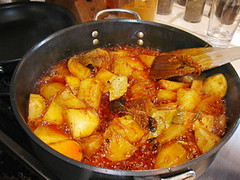
Potatoes, onions and spices for Tahiri
Very long-grain basmati rice is added and the whole thing simmers into a rich, tasty combination that Tariq described as a "lazy mom dish." Obviously Tariq didn't grow up in a place where Cheez-whiz and crackers are a lazy mom dish.
Dodo also made Borani, a dish of sauteed eggplant slices layered with yogurt that has been mixed with a lot of fresh, pressed garlic. Then that is topped with Anaheim chiles that have been cut into chunks and sauteed with lots of oil, cumin and carom seed (also called "ajwain" in India).
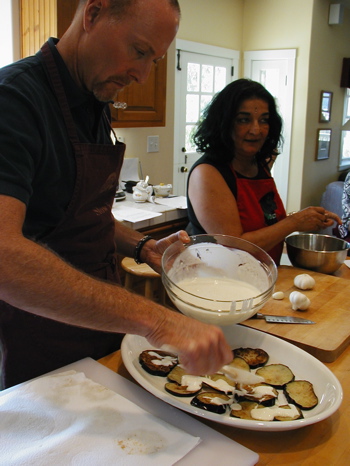
Preparing layers of eggplant for Borani
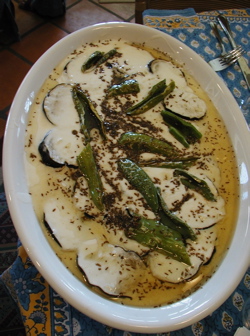
The finished dish
When the dish is finished, there are pools of oil on top of the yogurt, a sight you never see in the fat-phobic United States. Dodo explained that you could take as much oil or as little as you wanted when you served yourself.
"And when it comes to matters of food," she said, smiling, "I rather think that more is better than less."
The Tahiri was served with a garlic-and-chili powder-based Red chutney and a mint and chile-based Green chutney. Dodo also brought along some tomato chutney and a lemon pickle for us to taste.
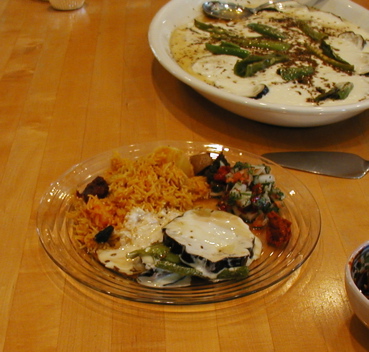
The finished meal
The flavors of the food danced like fireworks on our tongues as we ate our lunch. With our meal, we drank a Rancho Sisquoc Riesling or a Santa Barbara Winery Pinot Noir, two fruity, not-too-dry wines to go with the spiced dishes. Good conversation made the food even tastier, and when we finally left about 2 pm, the warm feelings that a satisfying meal and pleasant company bring followed us out the door like a soft Ojai breeze.
It was in this setting that we eight eager cooking enthusiasts came to learn a bit about Pakistani cooking from the talented Dodo Mufti.

Two men well-known in the local food scene hosted the class in a sweet farmstyle hideaway on a hill outside of town. They have a fabulous kitchen that manages to be both professional and cozy at the same time - it features both an industrial-strength Viking range AND three Laborador Retrievers (one in each color).
Dodo is originally from Bombay (Mumbai) India and learned to cook at the side of her mother-in-law, a Pakistani.
Pakistani food has much in common with Northern Indian cuisine, explained Dodo and her husband Tariq. The garam masala spice mixes are ground exceedingly fine, dishes are served with a variety of chutneys, and usually, meals from the Muslim country are meat-based, unlike the more vegetarian Hindu south. But today's adventure was pure vegetarian, a perfect lunch meal for a warm day.
In fact, Dodo said, the eggplant dish would only be served as a lunch, never as a dinner. Like the musical ragas that are only played at certain times of the day, there are dishes that are inextricably tied to a certain meal. And they are eaten in a certain fashion: when rice is served, bread is not.

Onions for Tahiri
Dodo began by explaining how to slice an onion in very thin strips for Tahiri, a rice and potato dish. The onions need to be fine and even so they caramelize perfectly before potatoes are added to a pan of the cooked onions, oil and spices. The potato chunks are partially cooked, then put with the other ingredients into a rice cooker.

Potatoes, onions and spices for Tahiri
Very long-grain basmati rice is added and the whole thing simmers into a rich, tasty combination that Tariq described as a "lazy mom dish." Obviously Tariq didn't grow up in a place where Cheez-whiz and crackers are a lazy mom dish.
Dodo also made Borani, a dish of sauteed eggplant slices layered with yogurt that has been mixed with a lot of fresh, pressed garlic. Then that is topped with Anaheim chiles that have been cut into chunks and sauteed with lots of oil, cumin and carom seed (also called "ajwain" in India).

Preparing layers of eggplant for Borani

The finished dish
When the dish is finished, there are pools of oil on top of the yogurt, a sight you never see in the fat-phobic United States. Dodo explained that you could take as much oil or as little as you wanted when you served yourself.
"And when it comes to matters of food," she said, smiling, "I rather think that more is better than less."
The Tahiri was served with a garlic-and-chili powder-based Red chutney and a mint and chile-based Green chutney. Dodo also brought along some tomato chutney and a lemon pickle for us to taste.

The finished meal
The flavors of the food danced like fireworks on our tongues as we ate our lunch. With our meal, we drank a Rancho Sisquoc Riesling or a Santa Barbara Winery Pinot Noir, two fruity, not-too-dry wines to go with the spiced dishes. Good conversation made the food even tastier, and when we finally left about 2 pm, the warm feelings that a satisfying meal and pleasant company bring followed us out the door like a soft Ojai breeze.
Subscribe to:
Comments (Atom)
